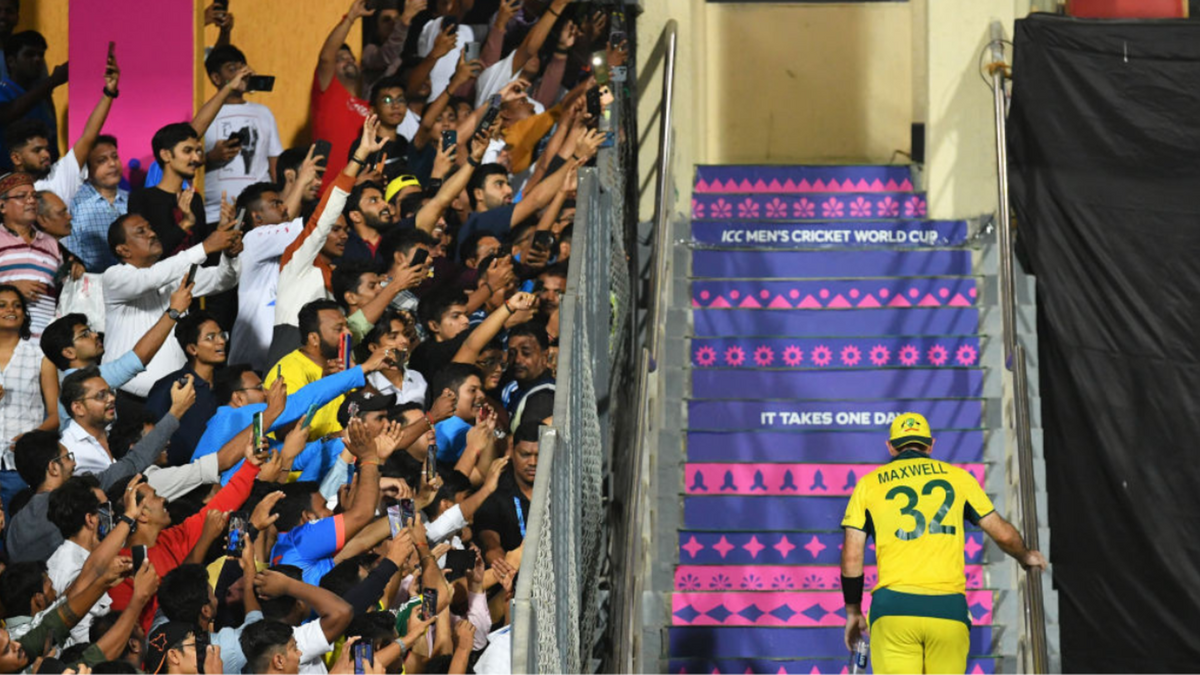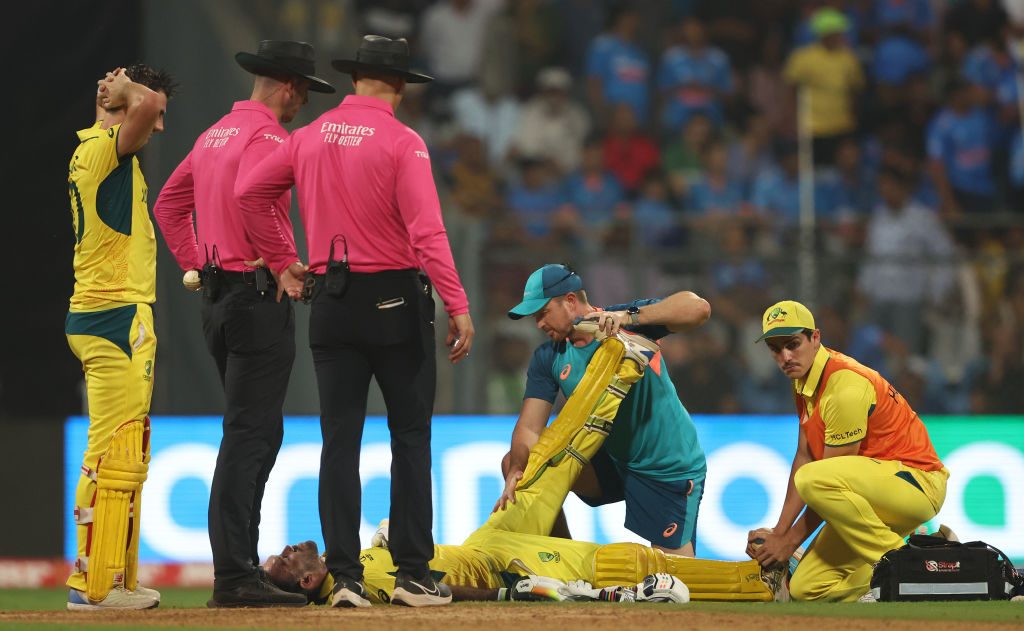
Glenn Maxwell played an innings in Mumbai that will live on for as long as the game of cricket does. Naman Agarwal, who was at the Wankhede Stadium to witness history unfold, relives the knock.
To bet on the World Cup with our Match Centre Partners bet365 head here.
Shivering fingers inside Wankhede Stadium’s freezing press box collectively (and aggressively) tapped away at keyboards. Reports that had been half-written in anticipation of a result which looked secure a couple of hours back, had been rendered moot. On the other side of the glass wall, a man struck down by the Mumbai heat and humidity had just pulled off the greatest heist in the history of one-day cricket.
There are several angles to look at Glenn Maxwell’s knock. Stats will paint a remarkable picture. The qualitative brilliance of his shots will make your jaw drop. Reactions, memes, tweets, and Instagram edits infused with uplifting background scores will make you watch and re-watch. But to feel the true essence of what transpired on a Tuesday night in Mumbai, you will need to place yourself at the heart of the crime scene, inside the Wankhede Stadium.
Let’s take you through the journey.
When Glenn Maxwell came in to bat in the ninth over during Australia’s run-chase against Afghanistan, the crowd was firmly behind Azmatullah Omarzai. He had just snared two wickets off two balls, reducing Australia to 49-4. With the new ball hooping around corners under the influence of the lights and the trademark Mumbai sea breeze, it felt as if the crowd ran in with the bowler for his hat-trick ball.
Maxwell somehow managed to get his bat down in time to a full delivery angled into his stumps. A thickish but soft outside edge took the ball towards slip along the ground. The Afghans appealed for a leg before wicket. Vociferously. Even the crowd appealed with them.
The collective euphoria, aside from the rapidly building momentum, had understandably dimmed their logical thinking. Afghanistan went for the review. As replays showed that the ball never touched Maxwell’s pads, there was a collective sigh of realisation from everyone who thought it would torpedo into the middle of middle stump.
[breakout id=”0″][/breakout]
Maxwell survived, but it felt it wouldn’t be for long. The game looked like it was slipping away from Australia’s grasp all too soon. Nine overs later, there was another DRS brainfade. Mitchell Starc walked back without reviewing a caught-behind despite not hitting the ball.
At that point, Australia were 91-7 in 18.3 overs, needing another 201 runs. The writing was on the wall.
Even the great Australian team of the 2000s that instilled genuine fear in the hearts of opponents would have been given just an outside chance, let alone this one that lost two of their opening games in the World Cup.
Pat Cummins, the No.9 batter, managed a streaky boundary off his third ball, following which the action seemed to calm down for a bit in the middle. Before that, almost every ball had been an event.
From the first-ball four by David Warner to the second-ball wicket of Travis Head, from the near hat-trick by Omarzai to the acrobatics of Rashid Khan and Ikram Alikhil: there had simply been no time for anyone watching or playing to take in and process all that had transpired so far in the Australian innings.
Which is why, when Cummins’ first boundary, an inside edge off Rashid, was followed by a two over period of relative lull, the magnitude of what was happening started hitting people. Conversations in the press box started shifting from the immediate awe of watching a spectacular bit of cricket, of which there had been plenty, to the wider implication of the direction in which the game was heading.
Would it be fair to call it an upset? Afghanistan may have beaten World Cup winning teams not long ago, but this was Australia, not one but five-time World Champions. Was this the cricketing response to Australia’s refusal to play Afghanistan earlier this year? Was Afghanistan sneaking into the semi-finals? Questions were aplenty, as was the buzz; reports and narratives of Australia’s collapse and Afghanistan’s seemingly unstoppable juggernaut started getting penned down.
In the 22nd over, when Maxwell was given out lbw on the field off Noor Ahmad, it signalled game, set, match. Being the last recognised batter, he took the review, but when the replay flashed on the big screen, Maxwell knew he was in trouble. He was nearly halfway back when in a remarkable stroke of luck, ball tracking showed that the ball would have bounced over the stumps. Maxwell had a life. The crowd knew it would only delay the inevitable. And they were right. Almost.
Four balls later, Maxwell top edged a sweep straight to Mujeeb at short fine leg. It looked so simple that even before it reached the fielder, a lot of people stood up from their seats to leave. Game, set, match, take two.
Of course, Mujeeb dropped it. Those who stood up had to sit back down. For great comebacks, you need little slices of luck. This one was soon to become the greatest.
[breakout id=”1″][/breakout]
From the next ten overs, Australia scored at least one boundary in eight as they went from 113-7 to 183-7. The momentum was steadily shifting, but the gap was still too wide. With more than a 100 runs still to get, everyone seemed to be going through the motions. Any moment, one of Maxwell’s random reverse laps or cross batted hoicks to the leg side would land in the hands of a fielder. The thought went on for over an hour. By then, Maxwell was already on his way to something extraordinary.
He reached his hundred off his 76th ball, having already scored a 40-ball ton earlier in the competition. There was no extravagant celebration given the state of the game, but the knock had once again reinforced his quality. Since the start of 2022 till just before the World Cup, Maxwell had averaged 26.5 from 12 ODIs with just one 50-plus score. There were a few doubts over his place in the side, which he had successfully quashed over the course of this tournament and this knock.
And then, quite dramatically, came a physical setback. First with back spasms, then with cramps in his legs, and then with both. The rotation of strike had to stall. Maxwell only had boundaries to play with. At the 40-over mark, Australia had reached 232-7, requiring only another 60 off 60 balls.
[caption id=”attachment_591255″ align=”alignnone” width=”1024″] Glenn Maxwell’s epic double hundred at the Wankhede Stadium came on the back of extreme physical pain.[/caption]
Glenn Maxwell’s epic double hundred at the Wankhede Stadium came on the back of extreme physical pain.[/caption]
[breakout id=”2″][/breakout]
The momentum that had been with the fielding side ten overs back, had well and truly shifted allegiance. The crowd which was wilfully intoxicating itself with one Glenn Maxwell shot after the other, realised that Australia were in with a real shot now. And when they did, you could physically feel the energy around the Wankhede Stadium switch.
It is perhaps that energy, coupled with the Australian physio’s words (and work) that forced Maxwell to stay back and finish the job. Not too long ago, he had found himself not able to move an inch, laying flat on the ground in the 41st over.
Every boundary that Maxwell hit had found cheers all throughout. But now, every ball that Cummins blocked got the crowd going. The crowd’s switch of support was complete. The definition of inevitable had now changed. Maxwell, still dangerously disbalanced but still smashing balls away, now had the Wankhede behind him. Australia now had Wankhede behind them.
Mujeeb started the 47th over with Australia needing 21 more runs for victory. They were still only three wickets away from what would now be a heartbreaking defeat if it were to happen, but the final judgment from the crowd had seemingly arrived. Australia were not losing this.
The first ball didn’t fetch a run. The second and third went into the stands. The fourth, a back of length ball around off stump, was unbelievably smashed past cover for four. And on the fifth, it was game, set, match, take three. Glenn Maxwell had just played the finest one day innings of all time.








